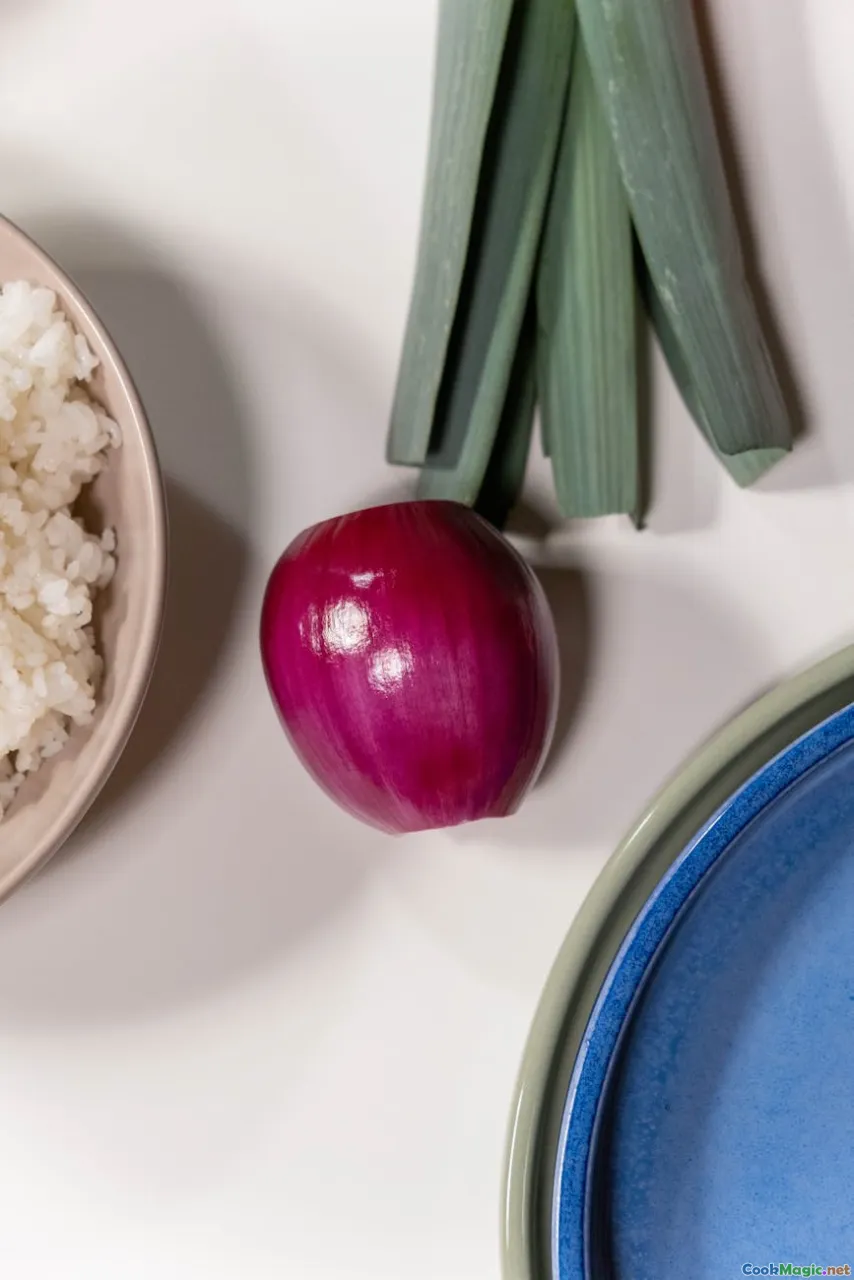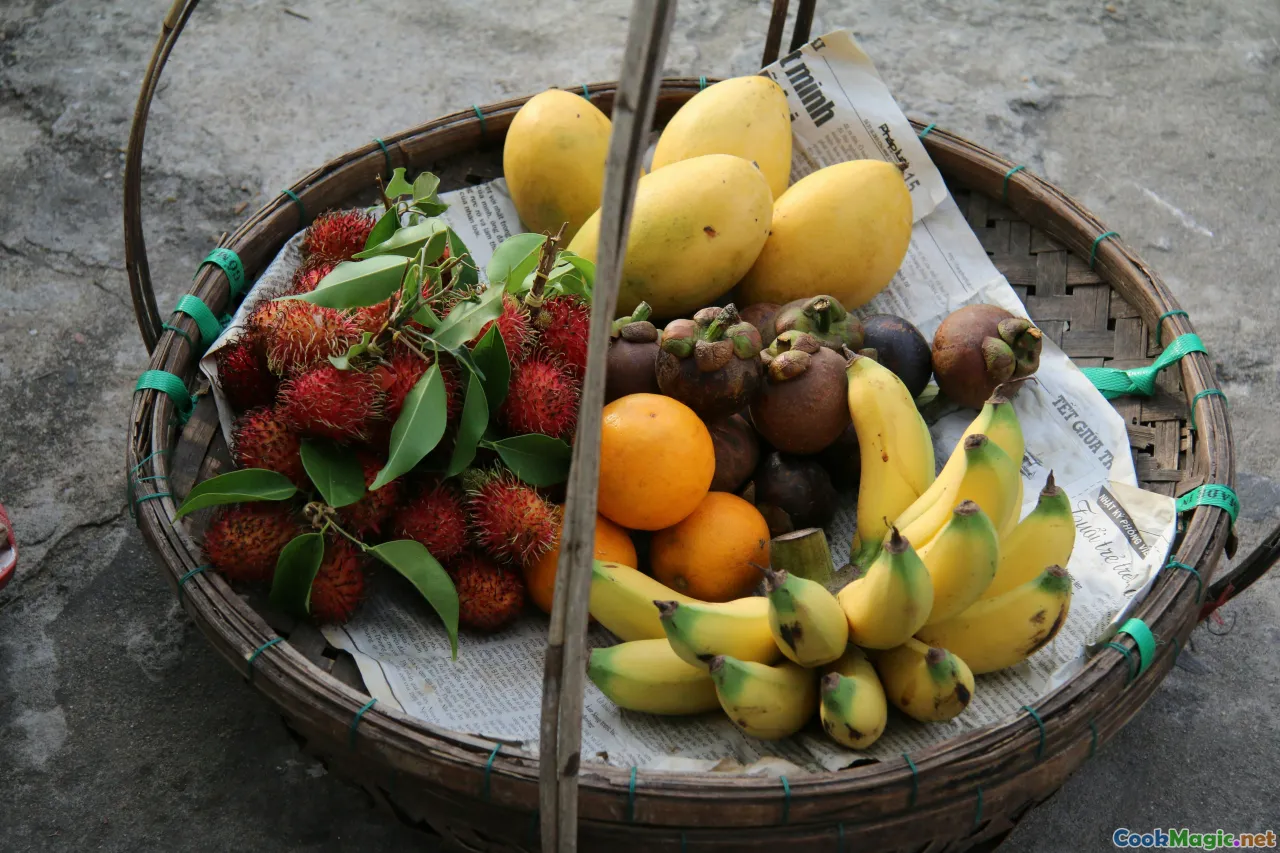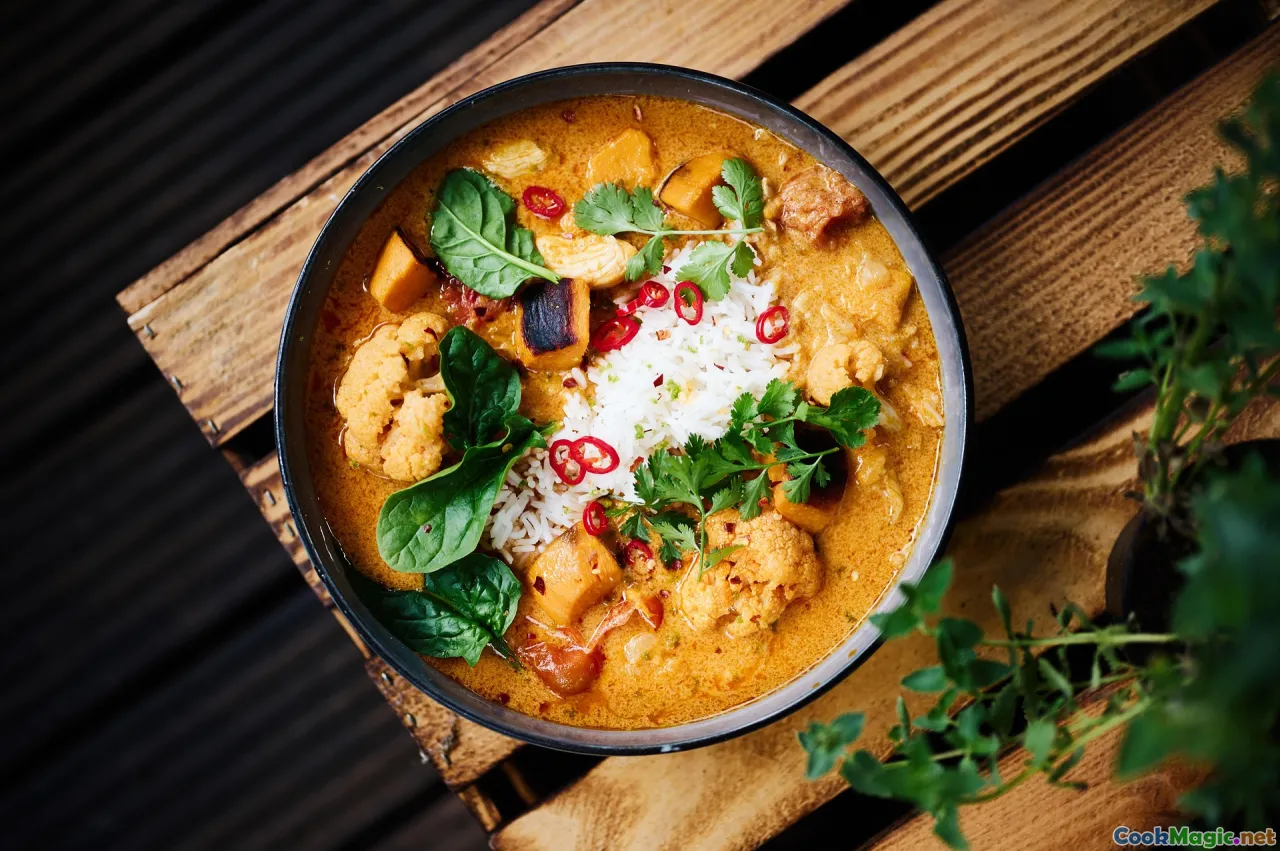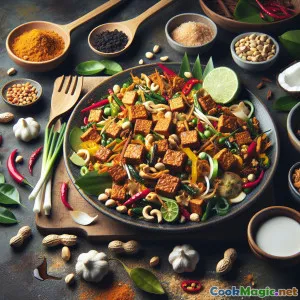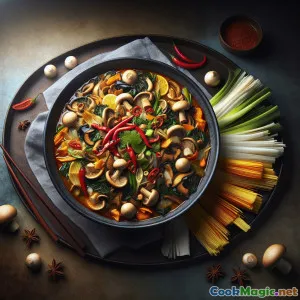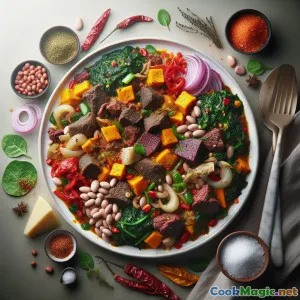
Tiệc Rendang mít khói xả và Cơm thảo mộc thơm
(Smoky Jackfruit Rendang & Aromatic Herb Rice Feast)
(0 Đánh giá)0
1,403
tháng 7 22, 2025
Báo cáo sự cố
Nguyên liệu
-
600 grams Mãng cầu non đóng hộp ngâm trong nước muối
(Rửa sạch và để ráo)
-
400 ml Sữa dừa
(Full fat preferred for richness)
-
5 whole Hành tím
(Cắt mỏng)
-
4 cloves Tỏi
(Băm)
-
3 cm Gừng
(Bóc vỏ và bào)
-
2 whole Cây sả
(Bầm dập)
-
5 leaves Lá chanh Kaffir
(Xé)
-
3 cm Riềng
(Optional, peeled and sliced)
-
3 whole Ớt đỏ
(Điều chỉnh theo mức độ nhiệt mong muốn)
-
2 tsp Bột ngò rí
-
1 tsp Bột thìa là
-
1 tsp Bột Nghệ
-
2 tbsp Nước tương
(Can sub with tamari for gluten-free)
-
2 tbsp Đường thốt nốt
(Or coconut sugar)
-
1 tsp Muối
(Theo khẩu vị)
-
2 tbsp Dầu dừa
(Để xào)
-
250 grams Gạo Basmati
(Rửa sạch)
-
450 ml Nước
-
1/2 cup Rau mùi tươi
(Băm)
-
1/2 cup Lá bạc hà tươi
(Băm)
-
1 whole Chanh (dùng trang trí)
(Cắt thành miếng)
(Rửa sạch và để ráo)
(Full fat preferred for richness)
(Cắt mỏng)
(Băm)
(Bóc vỏ và bào)
(Bầm dập)
(Xé)
(Optional, peeled and sliced)
(Điều chỉnh theo mức độ nhiệt mong muốn)
(Can sub with tamari for gluten-free)
(Or coconut sugar)
(Theo khẩu vị)
(Để xào)
(Rửa sạch)
(Băm)
(Băm)
(Cắt thành miếng)
Dinh dưỡng
- Khẩu phần: 4
- Kích thước khẩu phần: 1 đĩa (250g)
- Calories: 570 kcal
- Carbohydrates: 71 g
- Protein: 7 g
- Fat: 28 g
- Fiber: 9 g
- Sugar: 9 g
- Sodium: 1030 mg
- Cholesterol: 0 mg
- Calcium: 120 mg
- Iron: 2.3 mg
Hướng dẫn
-
1 - Prepare the Rendang Paste:
Blend shallots, garlic, ginger, galangal (if using), red chili, coriander, cumin, and turmeric with a splash of coconut milk into a smooth paste.
-
2 - Sauté Aromatics:
Heat coconut oil in a large pan over medium heat. Add the paste; fry until fragrant and color deepens, about 8 minutes.
-
3 - Add Jackfruit and Coconut Milk:
Add drained jackfruit; stir to coat in the spices. Pour in remaining coconut milk, add lemongrass and kaffir lime leaves.
-
4 - Simmer the Rendang:
Simmer uncovered, stirring frequently, until sauce thickens and jackfruit draws in flavor—about 30 minutes. Add soy sauce, palm sugar, and salt. Cook 10 minutes more until rich and caramelized.
-
5 - Prepare Herb Rice:
While the rendang simmers, cook rice: bring basmati rice, water, and pinch of salt to a boil; cover and simmer 12 minutes. Off heat, stir in chopped coriander and mint leaves.
-
6 - Serve and Garnish:
Serve jackfruit rendang over the fragrant herb rice. Garnish with extra fresh coriander, mint, a wedge of lime, and shredded kaffir lime leaf if desired.
Blend shallots, garlic, ginger, galangal (if using), red chili, coriander, cumin, and turmeric with a splash of coconut milk into a smooth paste.
Heat coconut oil in a large pan over medium heat. Add the paste; fry until fragrant and color deepens, about 8 minutes.
Add drained jackfruit; stir to coat in the spices. Pour in remaining coconut milk, add lemongrass and kaffir lime leaves.
Simmer uncovered, stirring frequently, until sauce thickens and jackfruit draws in flavor—about 30 minutes. Add soy sauce, palm sugar, and salt. Cook 10 minutes more until rich and caramelized.
While the rendang simmers, cook rice: bring basmati rice, water, and pinch of salt to a boil; cover and simmer 12 minutes. Off heat, stir in chopped coriander and mint leaves.
Serve jackfruit rendang over the fragrant herb rice. Garnish with extra fresh coriander, mint, a wedge of lime, and shredded kaffir lime leaf if desired.
Thông tin thêm về: Tiệc Rendang mít khói xả và Cơm thảo mộc thơm
Jackfruit Rendang with Fragrant Herb Rice
Jackfruit rendang merges the soul-warming comfort of Indonesian classic rendang with the lightness and creativity of contemporary plant-based dining. The dish takes inspiration directly from the Sumatran roots of rendang where slow-cooked, deeply spiced beef is the hallmark. Replacing beef with young green jackfruit is not only a novel but an increasingly popular choice among global home cooks, exposing rendang's legacy to vegan palates while honoring original Southeast Asian spice traditions.
History and Cultural Significance
Originating from Minangkabau culture, rendang represents celebration, communal gatherings, and festive tables throughout Indonesia, Malaysia, and neighboring regions. Traditionally beef-based, rendang’s main identity lies equally in its warming aromatics—lemongrass, kaffir lime, galangal, ginger, chili, and coconut.
The slow-cooked technique caramelizes the flavors until the sauce clings thickly to its protein, with the end result being something deeply savory, sweet, somewhat smoky, and with a complex web of spice reminiscent of Rayu sauce but infinitely more intricate.
Using jackfruit as the vessel is more than a substitute; it tells a story of cultural innovation. The fibrous structure of jackfruit mimics the flakiness of slow-cooked beef or chicken, but brings its own subtle, sweet vegetal notes and ability to absorb any flavor profile. In South and Southeast Asia, jackfruit has forever been a food of the people—ripe jackfruit is a summer treat; its unripe, meaty form is a blank canvass ripe for gastronomic adventure and texture.
Unique Recipe Aspects & Tips
1. Choose Green Young Jackfruit
Always opt for young jackfruit packed in brine or water (not syrup). Be sure to rinse and drain it very well—to wash away any canned taste and to prevent the final dish from being overly salty.
2. Slow Simmering Is Key
Patience is required for the authentic rendang flavor profile. Cook your spice paste well so the sugars caramelize and mature. Then let jackfruit and coconut milk simmer until all liquid thickens and jackfruit shreds easily.
3. Herbs Make the Rice
Basmati provides fragrance and fluffy texture, while the generous addition of coriander and mint makes the rice a perfect aromatic counterpoint to the richly spiced rendang stew. Add the herbs after the rice cooks so they retain brightness and fresh color.
4. Adjust Heat & Sweetness
Feel free to moderate red chilies if you prefer milder rendang. Palm sugar is traditional for complexity, but coconut or brown sugar also works. Balance is key: the end flavor should be spicy, sweet, savory, and creamy.
5. Serve Family-Style
This is festive sharing food—present the rendang and fragrant rice on communal platters. Garnish with fresh herbs, plantain or cassava chips, and perhaps some extra sambal for those who like extra heat.
Personal Thoughts & Serving Suggestions
This plant-based rendition has the capacity to turn even the most skeptical guests into jackfruit converts. The resilience of the flavors—intense lemongrass, the rustle of kaffir lime, the touch of coconut—is brilliantly inviting and satisfying for an array of eaters.
Pair the jackfruit rendang and herb rice with a kerabu salad (spicy Malay salad with cucumber) for contrast, or sautéed Asian greens with garlic. For those missing the chewy dimension of beef, sear some store-bought tempeh cubes and stir them through the finished curry for extra protein.
Best of all, leftovers taste even better the next day as flavors continue to marry. The combination of rendang and herb-infused rice might be unlike anything you've served before, but it is deeply tied to centuries-old food wisdom.
Dive in, and let your senses travel across the islands of Indonesia—from the first spoonful to the very last grain of rice.

